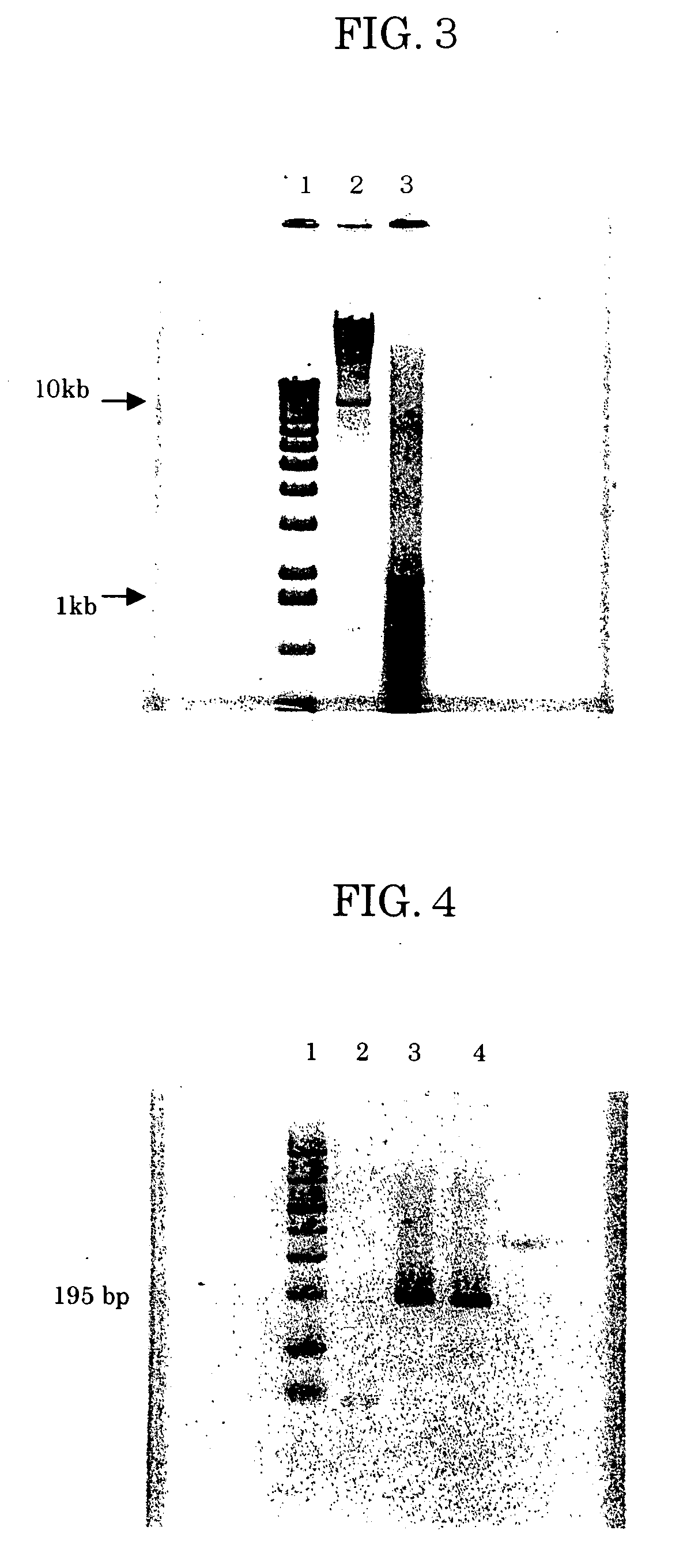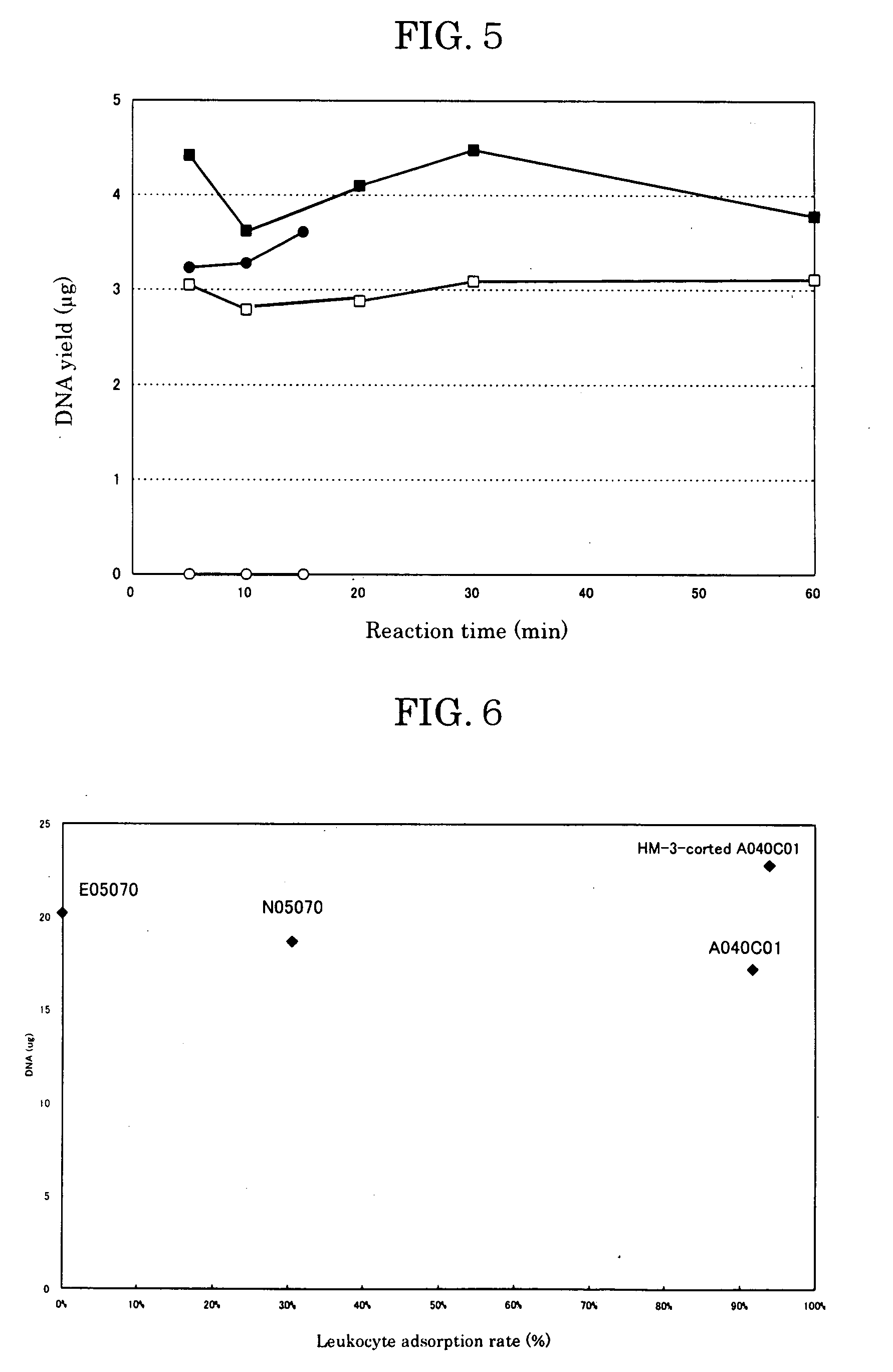Method of purifiying nucleic acid using nonwoven fabric and detection method
a nucleic acid and nonwoven fabric technology, applied in the direction of nucleic acid reduction, microorganisms, organic chemistry, etc., can solve the problems of requiring centrifugation, requiring more time and trouble, and requiring a large amount of time and trouble, so as to achieve a rapid and simple method of preparing nucleic acids, simple and high yield
- Summary
- Abstract
- Description
- Claims
- Application Information
AI Technical Summary
Benefits of technology
Problems solved by technology
Method used
Image
Examples
example 1
[0201] Purification of Nucleic Acid from Fresh Human Blood with Nonwoven Fabric
[0202] Blood was taken from a healthy donor and heparin sodium (Shimizu Pharmaceutical) was added as an anticoagulant at 10 units per milliliter of blood. The leukocyte count of the blood was measured with a flow cytometer (FACS Calibur, Becton Dickinson) using a LeucoCOUNT Kit (Becton Dickinson). The leukocyte count in 0.25 ml of blood was 1.16×106. The nonwoven fabric used was a product by Asahi Kasei Corp. The nonwoven fabric was cut into 12 mm-diameter disks, four of which were stacked and set in a filter holder (SWINNEX, MILLIPORE), with a 10 ml glass syringe set upstream and a suction pump set downstream in connection with the filter holder. The nonwoven fabric was initially washed with 3 ml of Digestion Buffer (10 mM Tris, pH 8; 100 mM NaCl; 25 mM EDTA; 0.5% SDS).
[0203] Next, 0.05 μg of Proteinase K (PCR-Grade, Roche) was added to 0.25 ml of the human blood, and after further adding 0.25 ml of 2×...
example 2
[0206] Analysis of Purified Human Nucleic Acid
[0207] The purified nucleic acid obtained in Example 1 was subjected to 0.7% agarose electrophoresis and the sizes were confirmed. After adding 1.5 μl of 10×Loading Buffer (1% SDS, 50% glycerol, 0.05% Bromophenol Blue, TaKaRa) to 10 μl of the effluent of Example 1 and thoroughly mixing, the total amount was subjected to 0.7% agarose electrophoresis. After electrophoresis in a Mupid Minigel Migration Tank (Advance) at 50 V for 90 minutes, the gel was stained with ethidium bromide and photographed with a BioImage Gel Print 2000i / VGA. As shown in FIG. 1, the purified nucleic acid contained nucleic acid fragments of various sizes of from several kilobases to several tens of kilobases.
[0208] It was then confirmed that the purified DNA obtained in Example 1 could be used as a PCR template. A glyceraldehyde 3-Phosphate Dehydrogenase (G3PDH) 0.45 kb Control Amplimer Set by Clontech (Cat. No. 5405-3) was used for primers. The effluent of Exampl...
example 3
[0210] Purification of E. coli Nucleic Acid
[0211] HM-3-coated A040C01 (Asahi Kasei) was cut into 12 mm-diameter disks, four of which were stacked and set in a filter holder (SWINNEX, MILLIPORE), with a 10 ml glass syringe set upstream and a suction pump set downstream from the filter holder. The nonwoven fabric disks were initially washed with 3 ml of Digestion Buffer (10 mM Tris, pH 8; 100 mM NaCl; 25 mM EDTA; 0.5% SDS)
[0212] After adding 50 μl of E. coli DH5 glycerol stock to 3 ml of LB medium (1 g Tryptone Peptone (DIFCO); 0.5 g Yeast Extract (DIFCO); 1 g NaCl; 200 μl 1N NaOH; 100 ml distilled water), the mixture was cultured at 37° C. for 4.5 hours to obtain a culture solution with A600=1.56. The E. coli density based on absorbance was considered to be approximately 6.2×109 cells / ml. A 1.6 ml portion of the culture solution (1010 E. coli cells) was taken and centrifuged at 15,000 rpm for 1 minute. The cell precipitate was suspended in 0.25 ml of LB medium. After adding 0.05 μg...
PUM
| Property | Measurement | Unit |
|---|---|---|
| temperature | aaaaa | aaaaa |
| pH | aaaaa | aaaaa |
| pore size | aaaaa | aaaaa |
Abstract
Description
Claims
Application Information
 Login to View More
Login to View More - R&D
- Intellectual Property
- Life Sciences
- Materials
- Tech Scout
- Unparalleled Data Quality
- Higher Quality Content
- 60% Fewer Hallucinations
Browse by: Latest US Patents, China's latest patents, Technical Efficacy Thesaurus, Application Domain, Technology Topic, Popular Technical Reports.
© 2025 PatSnap. All rights reserved.Legal|Privacy policy|Modern Slavery Act Transparency Statement|Sitemap|About US| Contact US: help@patsnap.com



